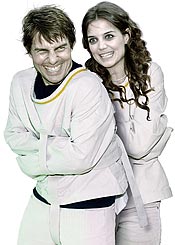
Our celebrities are mad as hell, and they’re not going to take it anymore. They’re on a dangerous rampage, and no one is safe. Christian Slater grabbed a woman’s bottom outside an Upper East Side deli, and Russell Crowe had a tantrum lengthy enough for him to rip a phone out of the wall, take it down the elevator, and throw it into the face of a clerk at the city’s most exclusive hotel. Dave Chappelle beat a quick path from his final Comedy Central tapings to South Africa, explaining he needed to go visit a friend, and Brad Pitt dyed his hair platinum (he got it done by Jen’s hairdresser!), played public footsie with Angelina Jolie, and paid the price with viral meningitis. Courtney Love, the patron saint of celebrity craziness, has been quiet lately, but getting larger. Who knows when she may erupt again. This summer, all outbreaks are only sideshows to the concurrent breakdown of Michael Jackson during his trial and the more recent mania of Tom Cruise, two of the biggest and most mysterious stars in the world unmasked as stark-raving lunatics. (The reeducation of Katie Holmes, the Manchurian Fiancée, continues apace.) Attack or be attacked: The other week, Leonardo DiCaprio was hanging out at a house party in the Hollywood Hills when one of the female guests hit him in the face with a bottle.

This is a country of big, of mega, and these are megastars having megabreakdowns, and we are megainterested. Something is wrong with Chris Tucker too—caught speeding at 109 miles per hour, he recently led cops on a ten-mile chase, later explaining he was late for church. It seems that celebrity egos have gotten out of control. It seems that the celebrity system has gotten out of control. The $20 million against 20 percent of the gross, the sponsorship money, the lava of free stuff. The freedom, the immortality, the fact that you will never be found guilty in a jury trial. Mariah Carey becomes a star at 18, and she never has to think about the weather for her entire adult life.
It seems there are so many more images of celebrities these days that there cannot help but be more out-of-control images, the curtain blasted to bits by the surveillance hive-mind that extends from paparazzi to stylist’s assistant tipped out by Us Weekly to neighboring Delano cabana guests. Then it seems the craziness might be happening because the increase in watching is the very thing creating the craziness. Then it seems that the beginning, middle, and end of the celebrity life story is finding a way to get people to keep watching and loving the star forever, so at a time when they are more watched and more loved than at any other point in history, they should not be going so crazy.
But they are.
The celebrity houses stretch along the Malibu shore, one after another, like a string of diamonds. From these three- (Courteney Cox Arquette) or four- (Julia Roberts) or five- (Ray Romano) bedroom modernist boxes by Richard Meier’s contemporaries, you can see the world clearly. From these soaring windows, the water is fine. They are built close to each other as in a city on their moss-covered stilts. Ten million dollars does not even secure a backyard, but the Pacific induces a state of Zen, and you even get a frisson of excitement that only the barest sliver of land separates you, George Clooney, from Halle Berry, or Mel Gibson from Britney and Kevin. Inside the glass bubble, you feel all alone. The only comfort is the wide-open ocean.
But here, in the middle of the Pacific, is Frank Griffin, 55, British co-owner of an L.A.-based photo agency, separated father of an 8-year-old son, and not one of the worst kinds of stalkerazzi but not one of the best either. He stands on the bow of the Full Moon, the new 41-foot Cranchi boat he purchased with his spoils from the first Tom and Katie shot in Rome, the first Jennifer Lopez and Marc Anthony shot, one of the first Britney Spears bumps that later turned out to be not a bump, or, in a gruesome side effect of newfangled tabloid reportage, the first photo of a bump that might have been a bump that didn’t last. Britney hates the paparazzi, especially now that she’s huge, like huge huge: “On a Britney car chase,” says a shooter for another agency, Splash, “you’re thirteenth in a line of cars following this racing madwoman: There’s nothing to do but close your eyes and hang on. It’s so dangerous! It’s my favorite part of the job.”
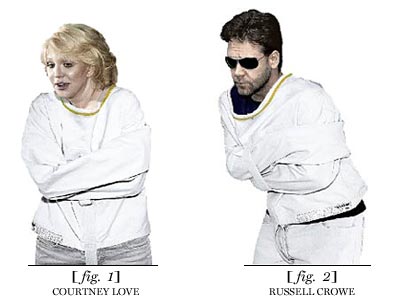
Today, Griffin is chill; he’s mostly out here showing off his new boat to two of his young charges, Danny Young and Mustafa Khalili, 28-year-old Brits whose nationality is clear despite their American uniform of khaki shorts, baseball caps, and slim Pumas in primary colors. Khalili returned from the beaches of Waikiki yesterday on the trail of Justin Timberlake and Cameron Diaz, two big stars who may hate the paparazzi even more than Britney, but he came back empty-handed, no cove giving up secrets, no hotel valet with a price on information, and later Griffin is going to give him hell. First, though, they’re going to check out Brad Pitt’s house.
The sea gets rougher as the boat turns upwind, houses streaming by faster now, the one with the dark wood (Stephen Dorff’s) and the apricot one with green trimming (Leo’s mom’s) and finally the one Jennifer Aniston leases for upwards of $25,000 a month, which has all the blinds closed—no photo today of the bikini-clad America’s Sweetheart reading a script on a chaise longue, that ubiquitous tabloid shot that tends to be followed by a caption about how she’s recovering from a Shiatsu massage (Aniston, all tabloid readers know, gets massages daily). Griffin knows Aniston—his man in Chicago got her walking on Lake Michigan yesterday with her hairstylist, Chris McMillan. “He’s trying to get Brad and Jen back together, but it’s not going to work,” declares Griffin, who has a lot of strong opinions on such topics. “When it came to Angelina, Jen couldn’t forgive that; perhaps if they’d had children, he would’ve been more discreet. It was Angelina’s choice to out the relationship, though, with the photographs from Kenya.” He bangs his hand on the thin tan wheel. “Brad flew to Mombasa on a private plane! The information came from her camp!”
A few whitecaps swirl around a buoy commandeered by happy seals. “That looks fun,” says Young. “Until a shark comes along, and then—” He brings his hands together in a loud clap.
The boat pulls near Brad’s. Built into a cliff, the house has a long series of windows shaped like an eye, staring right at us. Griffin stares back and raises his binoculars. “Come on, Brad,” he implores. “Give it up.”
At the most basic level, it’s people like Griffin, with an army of furtive men with digital cameras, who are driving celebrities crazy. They are the snakes in the celebrity garden, lurking and leering, spoiling paradise. Or maybe they’re more like Jagerettes, handing out shots and getting everyone drunk on the celebrity-industrial complex, a shape-shifting behemoth that compensates for fewer ticket sales by producing more personality-driven lip glosses. The tabloid business is growing as the entertainment business is shrinking; perhaps eventually the former will overtake the latter, and stars will still be playing themselves.
The relationship between stars and paparazzi has certainly turned into bounty hunting, but it’s not entirely clear that physical safety is the only reason stars have lobbied for the LAPD to begin an investigation into the paparazzi, given symbolic heft by the recent car accident between Lindsay Lohan and a “pap” on a trendy Nolita-esque corner of West Hollywood. Celebrities don’t want to ignore the paparazzi anymore—the stories they fuel have gotten so big they’re ending up on the CNN ticker. So life takes place behind half-drawn blinds. They should have known better when they moved in, or perhaps they’ve only just started to mind that Malibu, with a Nobu in the quaint mini-mall, has in the past few years become Star Country, and thus a leading spot for paparazzi, stalkers, starfuckers, fans, and all manner of untoward elements who seek to suck the energy right out of the star and leave no excess warmth of heart for him to bestow on the charity of his choosing.
And Griffin is taking more than their pictures. Gossip, particularly of the unsourced British variety, is the leader in celebrity irritants, as discerned in a study of celebrity stressors by Charles Figley, a professor at Florida State University. The gossip keeps pouring in as we simultaneously honor and revile our celebrities in a more intimate manner than ever before; today is only another day in the inexorable progress of a full Britification of our celebrity press. What’s important now is less the dissonance between actor and onscreen roles and more the difference between the image the celebrity is selling and the way he “really” is. Most of the paparazzi you come across in L.A. are Brits, relentless greyhounds of war with an attitude. “Americans can’t do this job—they don’t want to make $2,000 a day legally,” sneers Griffin.
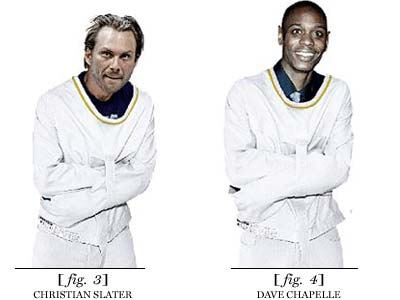
The camera doesn’t lie, you were in this place at that time, Jennifer Garner is clearly many months pregnant and having a shotgun wedding to Ben Affleck at Parrot Cay, but then there’s the backstory too. (Are you really happy? Do you hate that Ben smokes? Are you secretly terrified of J.Lo?) Paparazzi, more than ever, are the sources on text accompanying photographs. Exaggeration is what tabloids traffic in, and photographers can be happy to oblige—they often submit text to editors along with their photos, text that can be phoned in from a place called Imagination.
If not paparazzi, there’s always someone else to sell you out. Even your own publicist. “Some publicists are part of the problem,” says Ken Sunshine of Sunshine Consultants. “To get attention for their unknowns, people sell out their A-list clients, who are too dumb and too naïve to realize this is being done to them. The income stream is a volume business.”
Lindsay Lohan and Paris Hilton have both claimed to have excommunicated friends whom they set up with false information that later appeared in print. (No word if each was the other’s friend.)
Finally, as any reader of the supermarket tabloids can tell you, truth and falsehood are beside the point. There’s a phantom being, a doppelgänger, out there with your name on it, and you can’t control the way it’s behaving. Once you have been cast in a story line, there is no way out. It’s been a year since the tabs first wondered if Nick Lachey and Jessica Simpson were going to break up, and the cover of last week’s Star magazine still asks, nick & jessica: over by xmas? It is now necessary for Jennifer Aniston to bounce back from her divorce and engage in a deep friendship with Vince Vaughn, her co-star in a new movie called, of course, The Breakup. Inevitably, in the next news cycle, Jen collapses on the way to dinner with friends because the divorce process is “taking an unmistakable toll.”
In the final indignity, the same photo of Aniston walking her dog may be used one week to show her independence—she’s enjoying things for herself!—and the next week to demonstrate her unhappiness (“She tried to relax by taking her dog, Norman, on a long walk”).
Of course, this is only the stuff that gets printed. Any bit of information posted on a blog flies across the Internet and sticks. The gaze is intense and permanent. “My clients are concerned about speed,” says Leslee Dart of the Dart Group. “You print a false rumor, and within an hour, it’s disseminated worldwide. The ability to set the record straight has become impossible.” The expanding world market needs to be fed: When I was with Griffin, he got a call from his distributor about a new account in Croatia. “There you go,” he crowed. “A few years ago, they’re slaughtering each other, and now they’re buying pictures of Britney Spears’s crotch.”
These days, we talk about celebrities like they’re our friends—or former friends. On a recent night at Koi, the trendiest sushi restaurant in all L.A., Kato Kaelin, older, ruddy-cheeked, in a fringed leather jacket, is the only celebrity inside.
A middle-aged woman in a yellow pantsuit comes out of the restaurant and takes a picture of the paparazzi with her cameraphone. A tall couple in slightly too dressy evening attire slither toward the valet. “Who did we miss in there?” they ask each other.
“Angelina and Brad,” jokes the woman. “He’s got her on the table. He’s like, ‘I love sushi!’ ”
“Sa-shimi!” says the man. It’s so hard to be a star—and no one cares. Stars are not just like us. According to researchers, celebrities are four times as likely to commit suicide as noncelebrities and live, on average, thirteen years less than Joe and Jane Sixpack. Celebrities may receive substandard treatment at hospitals, victims of deferred medical tests or competition between surgeons for the honor of operating on a celebrity. Celebrities may experience more insomnia, migraines, and irritable-bowel syndrome. Celebrities are twice as likely to develop a serious alcohol problem.
And who’s to blame for this tale of famous woe? Well, Mommie Dearest, of course. “In every autobiography of a famous person, you find that a parent has either died, been punishing, or been terribly neglecting,” says Sue Erikson Bloland, a psychoanalyst in private practice and daughter of ego psychologist Erik Erikson, whose childhood followed a similar pattern. This void is then filled by a mentoring figure, a grandparent or teacher or even the other parent, who makes a narcissistic investment in the star. The child grabs the chance at love, but it’s a trap. Jessica Simpson’s lifetime of encouragement from her father, the one who pushed her to sing and also made her promise to remain a virgin (his virgin) until she married, is all about reducing her to his puppet (a pretty puppet).
Not content to leave the study of celebrities to tabloid body-language experts, the psychological community is coming to terms with celebrity psychopathology. The modern medical term—the famous term, the celebrity term, the superstar of psychological monikers—is acquired situational narcissism (coined by a doctor who may know whereof he speaks, since he refused an interview because he didn’t appear in the “Best Doctors” issue of this magazine).
Are the crazy drawn to Fame, or does Fame make them crazy? ASN claims the latter. To a celebrity, narcissism is a rational response to a world that functions as a mirror, amplifying one’s positive self-image, the sense that one is in the absolute center. It arrives later than classical narcissism—which sets in between the ages of 3 and 5, once a realistic view of the world begins to develop—but the disorders are indistinguishable, with patients exhibiting the same grandiose fantasies, excessive need for approval, lack of empathy, anger, and depression (how fabulous). Fearful of exposing the real them, narcissists project a glorified self that becomes so ingrained it becomes impossible to tell what’s real and what’s made up. This is the self they start talking about in the third person. Everyone must love this self or it risks dissolution. There must be Omnipresent Love. Speech becomes impressionistic and lacking in detail—a symptom celebrity profilers well recognize.
“The media and the movie industry don’t always agree with each other, but they’re both out to entertain,” says Steven Spielberg. “People should not be fooled.”
Celebrity, as John Updike wrote, is the mask that eats into the face. A study has shown that pop stars use personal pronouns in their songwriting three times more once they become famous; another study claims that the more famous one gets, the more one checks oneself in the mirror, and the more one’s self-concept becomes self-conscious. It’s a problem, to be both self-involved and self-conscious.
A Tinseltown version of post-traumatic stress disorder develops. Danger is around every corner. “The same thing happens to celebrities that happens because of war, because you’re in the middle of disaster, terrorism,” says psychologist Robert Butterworth. Last month, Catherine Zeta-Jones’s stalker was sent to prison after claiming she was going to blow Zeta-Jones’s brains out like JFK or slice her up like Manson did to Sharon Tate unless she stopped having an affair with George Clooney, which she wasn’t.
Trapped in their bubble, celebrities experience arrested development. The celebrity becomes an adolescent, a developmental stage that is non-age-specific. The time is the time before the blows to self-esteem that lead to a mature, realistic view of one’s weaknesses and strengths and a capacity for love that transcends self-love (Paris Hilton time).
But once again, the world impedes. Someone, a fired masseuse or peevish younger sister, tells the celebrity that he is full of it, or he loses out on the new Steven Soderbergh movie. Impostor syndrome sets in, with its attendant sense of fraudulence. The star begins to notice he has a limited skill set based upon a fortunate genetic hand dealt him. Emotionally intuitive creatures, they realize they’re surrounded by people smarter than they are—even their agents!—and that makes them insecure.
Wary of the gap between the false and true self, the star overcompensates by developing a God complex. Important people request the star’s largesse, as the many supplicating letters in Marlon Brando’s recent estate auction demonstrate, even one from Martin Luther King Jr. (“I have been subject to great personal strife and am obliged to go to Court Thursday,” Brando telegrams back. “I feel honored that you asked for what assistance I could give. I cannot at this time be of assistance.”) The star may be told, like Madonna has been by the rabbis of Kabbalah, that she is the reincarnation of Queen Esther. The star may be the tool by which the message of a body like Scientology is meant to be disseminated across all lands.The overall multiaxial assessment: Completely Out of Their Mind Personality Disorder With Multiple Insane Features, or, more succinctly, Beyond Diagnosis.
So who would want to be a star under these conditions? Listen to a star in the making: Ariel Gade, 8, at the premiere of mainstream horror flick Dark Water, when asked if she likes fame. “I love it,” she says, her voice quavering with excitement. “I’m just having such a good time tonight!” Does she want to be famous? “I’d like to be a director. I think directors are the coolest people around.” When I ask her if things were still the same with her friends, first she says yes, but then reconsiders: “Well,” she says, scrunching up her exquisite face, “actually, I’m home-schooled, so I don’t have any friends. But I do have cousins.” She starts to walk away but stops short. “Oh, and by the way, this is a Bill Blass design,” she says, holding out her pink tulle dress. “Bill Blass brought it over a few days ago, I don’t remember exactly when. Bill Blass gave it to me as a little gift.” (Which would have been nice, except Bill Blass is dead.)
Paradise is hanging out at the most private—but not too private—places around, like the exquisite Château Marmont garden, which mortals are discouraged from entering after nightfall, or Bungalow 8, the subway-car-size Chelsea bar with no VIP room that makes stars feel “normal” because each banquette features stars like a Mary-Kate Olsen or a Jay-Z, so that everywhere you look there is a reminder that you are in the right place, you have not made a mistake, you are as special as they say. Homage will be paid from celebrity to celebrity: “I went up to Angelina Jolie at an awards thing, and I just, I couldn’t help it, I started bawling,” says Anne Hathaway, star of The Princess Diaries, at lunch at the Central Park Boathouse on a recent Wednesday. “She’s been my favorite actress since I was 16. We watched each other in the eyes, and I could tell she had a beautiful soul. I guess she thought the same thing about me, because she asked me to go to Cambodia in association with her project. She said the sweetest thing: ‘Whenever I’m in a hotel room, I love watching your films, because even if it’s three in the morning, it makes me so happy.’ ”
No one has ever been safe in the House of Fame, though. Leo Braudy’s definitive study of fame, The Frenzy of Renown, traces the earliest mention of this house to Ovid’s Metamorphoses, where it rests on a mountaintop at the meeting point of land, sky, and sea. In Chaucer’s fourteenth-century poem “The House of Fame,” the house has become a castle with as many windows as snowflakes, packed with sorceresses and jugglers, magicians and wizards, celebrated singers like Orpheus and humble minstrels with bagpipes. A half-foot of solid gold covers the ceiling, walls, and floor of the great hall, where Fame herself presides from a throne made of ruby, her head extending to heaven and her body covered with as many “tongues as on bestes heres.” Her herald, Eolus, the god of wind, holds a trumpet of Praise and a trumpet of Slander, blowing from them as Fame pleases.
Tom Cruise, in all his lunatic effusiveness and paranoid defensiveness, is the definitive celebrity of this age. He’s the boy in the bubble. He’s said not to read his press, and has requested photo approval on shoots since his Risky Business days. One could not act as Cruise has if one understood how one’s actions were being interpreted. One could not pop the question to Katie Holmes at a candlelit dinner at the Eiffel Tower and announce the news at a press conference less than eight hours later, nor claim that methadone was originally called adolophine because “it was named after Adolf Hitler,” nor tell Matt Lauer, “There is no such thing as a chemical imbalance … Matt, Matt, Matt, Matt—you’re glib.” (A talk-show host, glib?) One could not be so forceful about such things unless one was Tom Cruise. “The exterior is only one covering,” he has said, equally forcefully. “I do not have a fear of life or death.”
In the bubble, the Cruise makes his own rules, as was evident at the New York War of the Worlds premiere last month. Even though Hollywood protocol dictates Major Star arrival only once all other beings have been stuffed in the theater, Cruise arrived two hours early. He wanted to press flesh, fans, reporters, curious bystanders, but particularly his new fiancée, whom he devoured with kisses.CAN I STEAL A KISS FROM TOM? read a placard held up by a fan.
Katie shook her head. Katie does not speak.
The hundred or so fans who got there early wore War of the Worlds T-shirts, and Cruise ran over to them, grabbing cell phones to say hello to mothers before he headed to the press line, where frantic arms stretched tape recorders over barricades. “We’re from British TV,” said one reporter. “I love Brits!” shrieked Cruise.
“We’re from Australian TV,” said the next reporter.
“I love the Aussies!” he yelled.
The reporter from People magazine was shaking: “I have no idea what’s on this tape,” she whispered. “It was like we went into a trance and got all giggly and girly. Tom touched my arm—he gripped it.”
Other guests started to arrive, like Hulk Hogan: “I think AFTRA should elect me as the commissioner of Demolition Paparazzi with a kind of above-the-law license, and let me handle each of them on an individual basis,” he said, twitching.
Steven Spielberg strode in—this is his movie, Tom is his guy, and no one’s messing with either of them. “The media has to make a lot of money the way that movies have to make a lot of money,” he said. “I’m very grown-up about this. They need to get out of a media slump the same way everyone’s like, ‘What’s going to get Hollywood out of their movie slump in ’04 and ’05?’ So when I see the media exploiting a couple, I know that’s another industry trying to make a lot of money off of the celebrity of these people. Then they get weeks of a good episodic series called the Tom and Katie series, the Ben and Jennifer series, the Brad and Angelina series.” He glowered. “The media and the movie industry don’t always agree with each other, but they’re both out to entertain,” he said. “People should not be fooled.”
Howard Stern and girlfriend Beth Ostrovsky greeted Tom and Katie, then sashayed down the red carpet. “I can’t believe the girl is 26 years old and still a virgin, but I do believe her,” said Stern. “On my show, I’d ask, ‘What does that mean, “to hold out”? Everything but? What exactly?’ ”
“Honey!” said Ostrovsky. “She was very nice to you about two minutes ago.”
“Am I being mean?” asked Stern. “I’m just curious. What if they get in bed and—who knows?—he doesn’t like her backside. There could be all kinds of problems. Then there’s the whole religion thing. Oh, I don’t know where to end. There’s all kinds of weird stuff going on there, jumping up and down on the couch on Oprah. I’m excited when I’m with a woman, but I don’t jump up and down on a couch—”
The Cruise did not hear any of this. He glided right past it. He was involved, steady, focused, making his way toward the theater as he took on questions about when he will get married, or if he feels competitive with Holmes—“I don’t have rivalries,” he said, “especially not with my love”—and how it feels to have Katie near him (“It’s very exciting”). Will he do Broadway? “If I can find the right thing,” he said. “I don’t know of any piece of theater I’d like to be doing, but I like dancing. I like dancing.”
Now Cruise was at the door. He turned around one more time, looking back over all he saw, all these hundreds of people swarming toward him in midtown Manhattan, the whole world watching, everyone interested expressly in the Cruise. From inside the bubble, he waved, like the good witch in The Wizard of Oz.
Of course, there’s another Tom Cruise—a couple of them, actually. The good Tom Cruise has some questionable twins. There’s the one who goes home and does God knows what with God knows whom—the real Tom Cruise. Then there’s the one who haunts certain blogs and numerous conversations. Who among us would believe any of this preposterous stuff, but there it is, wherever you look on the Internet. Did Tom Cruise ask Scarlett Johansson, Jessica Alba, and Kate Bosworth to be his girlfriend before picking Holmes, who was in fact his fifth-choice girlfriend? Ridiculous. Did he promise Holmes a five-year contract, worth $10 million with no conjugal duties, to play his wife? Who makes this stuff up? Rob Thomas of Matchbox 20 has even gone on record denying that Cruise was caught in Thomas’s bed by Thomas’s wife. (“If I was gay, Tom Cruise wouldn’t be on the top of my list,” he said. “It would be Brad Pitt.”) Word-of-mouth stories are even less believable, more like Eyes Wide Shut than anything that would happen to a megastar in the prime of his career. I bumped into a friend in the West Village last week who told me the most outlandish story of all: One time on Universal president Ron Meyer’s boat, Cruise put a mask on, the same mask from Mission: Impossible, and wouldn’t take it off. They docked and went to a nightclub. Cruise went to the bathroom. He met a guy. The guy wasn’t interested. He ripped off the mask and declared, “But I’m Tom Cruise!” The only response to this kind of lunacy is “And I’m Marie Antoinette!” Cruise is a figure of fantasy, stalking our dream lives, as surely as the paparazzi stalk him.
Except that many of us don’t believe it’s our dream life. Everybody thinks that they know what celebrities really do. They do it with gerbils, and with women not their wives, and under the influence of cocaine, and in bathrooms with people of the same sex. (Part of what’s so satisfying about Paris Hilton is that, before she turned into Ivana Trump, every single atom of her being told you her real life was every bit as lurid as any figment of the gossip imagination.) People tell you things, and they have such a ring of truth to them: “I worked with a male movie star who, when he became a male movie star of stature, would actively work the casting couch—not only proclaim the size of his penis, which was gargantuan, but willingly say servicing it was part of the program,” says a former agent. “Some women would run screaming from the room. Some would stay and become part of the movie. And I was his agent. I was his agent.”
When one makes about $80 million a picture, like Cruise does, one can pay for whatever handlers one wishes, and these handlers will become your friends, family, and confidants. (Just make sure they don’t have cousins at In Touch!) L.A.’s population is exploding, and I’m not sure that it’s not because people today are compelled to relocate to places where they could possibly work for, with, or near a celebrity. These days, a life as Julia Roberts’s assistant is not a lost life, but a life blessed, transmogrified, made shiny by her presence. To be in the entourage of such a star, either as landscaper, organic-food preparer, or second assistant, is to be made whole.
The people who help make stars beautiful are the ones they’re closest to—they see the Real You before the fake one. Jennifer Aniston moved in with her hairdresser when she and Brad split up. Therapists are great, but they’re hard to own—“You don’t have time to treat more than one celebrity at once, unless it’s Woody Allen,” says psychologist Stuart Fischoff. “They say, ‘I want to make sure, Doc, that I can call you 24 hours a day, seven days a week.’ Well, no, you can’t. ‘No one sets limits on me!’ ”
The aura of a celebrity extends over everyone he or she works with. “I’ve gotten thank-yous on albums, and that’s really great,” says Stuart Kaplan, star cosmetic dermatologist, multiple triple-platinum albums with plaques inscribed TO OUR DERMATOLOGIST hung throughout his Beverly Hills office. There he is, still at the office at 9:30 P.M., a lovable guy in blue Dickies, a Horace Mann graduate who misses New York but can’t give up the swell life. “I treated a kid whose father was a director, and he said, ‘Somehow, somewhere, you’ll have a character named after you in a movie,’ ” he says. Then he catches himself. “I am not a better doctor because I treat celebrities,” he says. “I am a better doctor because of my charitable work.”
Spoken like a celebrity.
Nowadays in the celebrity nuthouse, the inmates are running the asylum, only pretending that they’re the ones under observation. Brad Pitt owns the international rights to the lusty 60-page W magazine spread that cast Angelina Jolie as his wife. Michael Douglas and Catherine Zeta-Jones sold their wedding pictures for £1 million to OK!, the smarmy British tabloid that will open a U.S. office this fall and very likely broker more of such deals to the detriment of shallower-pocketed American tabloids. Gwyneth Paltrow and Chris Martin staged a paparazzi shot leaving her gynecologist after getting the news that she was pregnant, her brother’s girlfriend behind the camera.
Of course, for a narcissist, privacy is a relative concept. Often, it’s just part of the performance. Private, when a celebrity uses the word, means many things, perhaps “I’m classy” or “I don’t go to nightclubs” or “I’m shy,” but what it rarely means is “I’m private” and certainly not when a semi-naked photo shoot is involved. A few months ago, good-girl actress Hilary Duff, 17, explained to me in an interview that she couldn’t possibly divulge that she was dating rock singer Joel Madden—she was a private person, she said, and she had to save something for herself, otherwise what does one have? This made sense. Except a couple months later at the premiere of The Perfect Man, Duff’s new movie, there was Madden, covered in tattoos, his hair arrayed in a black-dyed faux-hawk—Hilary’s “Perfect Man,” as the entertainment-news programs put it. He mumbled something about Hilary being a great girl.
Public image, after all, is the business stars are engaged in. Nowadays, reality seems to be following fantasy, as stars become their tabloid selves. Angelina Jolie, best known for Tomb Raider, is now an A-list star. The affair with Brad Pitt has been a small price to pay. Manipulations of the machine can have real-life consequence. The May-December between Ashton Kutcher and Demi Moore, which began when both had projects to promote, has now produced a “bump.” No one is being fooled, and no one is in control. The circus has no ringmaster. Yet everyone is getting some of what he wants. And isn’t that what psychiatrists say a relationship is all about?
Conditions
[DCM* 100.1]
Exhibitionism
Celebrities with an exhibitionism disorder tend to favor halter tops, tattoos, even bare feet. Often (e.g., Paris Hilton, Rob Lowe) seen more memorably in amateur films than in professional ones.
Example: Britney Spears
[DCM 100.2]
Dissociative Behavior
Celebrities with dissociative-behavior disorder tend to behave in outlandish ways with no knowledge that others perceive their acts as out of the ordinary. Most often seen in megastars with extensive entourages.
Example: Tom Cruise
[DCM 100.3]
Inappropriate Romantic Partners
Celebrities who take inappropriate romantic partners only occasionally develop a sense of guilt and remorse, except (e.g., Hugh Grant) when a mug shot is involved.
Examples: Brad Pitt and Angelina Jolie,
Jennifer Aniston and Vince Vaughn

[DCM 100.4]
Body Dysmorphism
Body dysmorphism often develops in celebrities due to excessive media attention to secondary sexual characteristics (breasts, buttocks). The subsequent weight loss can be accompanied by guilt when the media focus on the celebrity’s extreme thinness, and on the bad example being set for the nation’s children.
Examples: Nicole Richie, Lindsay Lohan, Mary-Kate Olsen
* Diagnostic Celebrity Manual
Root Causes
[fig. 1]
Paparazzi Run-ins
In recent years, as fees for photographs have escalated, paparazzi have become more aggressive and predatory. Stars are beginning to fight back.
Example: Cameron Diaz
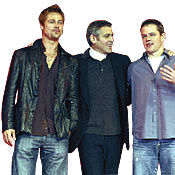
[fig. 2]
Limited Social Circles
Celebrities most often associate with other celebrities (indeed, this is one of the classic indications of narcissism), which exerts a distorting influence on their worldview and creates enormous competitive anxiety.
Examples: Brad Pitt, George Clooney, Matt Damon

[fig. 3]
Asocial Freedom
The absence of adult responsibilities or any normative pressures often leads to dissociative behavior (e.g., couch-jumping), outlandish costumes (e.g., pajamas), and plain freakishness.
Example: Michael Jackson
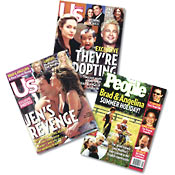
[fig. 4]
Tabloid Incongruity
The tabloids present a view of the celebrity world that is authoritative, though often not factually accurate or even internally consistent.
Examples: Us Weekly, People
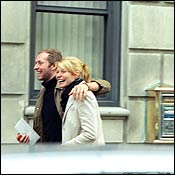
[Celebrity Therapy]
Gwyneth and Baby
As the celebrity system has evolved, celebrities more and more are learning to control it. This mock paparazzi shot, of Gwyneth Paltrow and Chris Martin happily leaving her gynecologist’s office, was actually taken by her brother’s girlfriend and sold to the tabs.
Additional reporting by Jada Yuan.